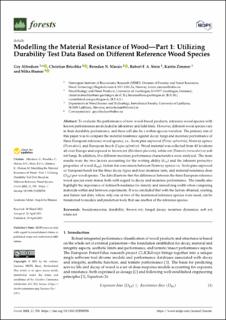Modelling the Material Resistance of Wood—Part 1: Utilizing Durability Test Data Based on Different Reference Wood Species
| dc.contributor.author | Alfredsen, Gry | |
| dc.contributor.author | Brischke, Christian | |
| dc.contributor.author | Marais, Brendan | |
| dc.contributor.author | Stein, Robert F.A. | |
| dc.contributor.author | Zimmer, Katrin | |
| dc.contributor.author | Humar, Miha | |
| dc.date.accessioned | 2021-10-11T10:39:04Z | |
| dc.date.available | 2021-10-11T10:39:04Z | |
| dc.date.created | 2021-08-24T12:27:39Z | |
| dc.date.issued | 2021-04-29 | |
| dc.identifier.citation | Forests. 2021, 12 . | en_US |
| dc.identifier.issn | 1999-4907 | |
| dc.identifier.uri | https://hdl.handle.net/11250/2788993 | |
| dc.description.abstract | To evaluate the performance of new wood-based products, reference wood species with known performances are included in laboratory and field trials. However, different wood species vary in their durability performance, and there will also be a within-species variation. The primary aim of this paper was to compare the material resistance against decay fungi and moisture performance of three European reference wood species, i.e., Scots pine sapwood (Pinus sylvestris), Norway spruce (Picea abies), and European beech (Fagus sylvatica). Wood material was collected from 43 locations all over Europe and exposed to brown rot (Rhodonia placenta), white rot (Trametes versicolor) or soft rot fungi. In addition, five different moisture performance characteristics were analyzed. The main results were the two factors accounting for the wetting ability (kwa) and the inherent protective properties of wood (kinh), factors for conversion between Norway spruce vs. Scots pine sapwood or European beech for the three decay types and four moisture tests, and material resistance dose (DRd) per wood species. The data illustrate that the differences between the three European reference wood species were minor, both with regard to decay and moisture performance. The results also highlight the importance of defined boundaries for density and annual ring width when comparing materials within and between experiments. It was concluded that with the factors obtained, existing, and future test data, where only one or two of the mentioned reference species were used, can be transferred to models and prediction tools that use another of the reference species | en_US |
| dc.language.iso | eng | en_US |
| dc.publisher | MDPI, Basel, Switzerland | en_US |
| dc.rights | Navngivelse 4.0 Internasjonal | * |
| dc.rights.uri | http://creativecommons.org/licenses/by/4.0/deed.no | * |
| dc.title | Modelling the Material Resistance of Wood—Part 1: Utilizing Durability Test Data Based on Different Reference Wood Species | en_US |
| dc.type | Peer reviewed | en_US |
| dc.type | Journal article | en_US |
| dc.description.version | publishedVersion | en_US |
| dc.rights.holder | © 2021 by the authors | en_US |
| dc.source.pagenumber | 19 | en_US |
| dc.source.volume | 12 | en_US |
| dc.source.journal | Forests | en_US |
| dc.source.issue | 5 | en_US |
| dc.identifier.doi | 10.3390/f12050558 | |
| dc.identifier.cristin | 1928299 | |
| dc.relation.project | Norges forskningsråd: 297899 | en_US |
| dc.relation.project | EC/H2020/773324 | en_US |
| dc.source.articlenumber | 558 | en_US |
| cristin.ispublished | true | |
| cristin.fulltext | original | |
| cristin.qualitycode | 1 |
Files in this item
This item appears in the following Collection(s)
-
Divisjon for skog og utmark [520]
Publikasjoner knyttet til ansatte ved Divisjon for skog og utmark -
Publikasjoner fra CRIStin - NIBIO [4531]
-
Vitenskapelige artikler [1416]

